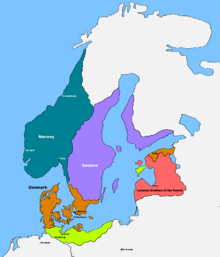Borders of Denmark


The
The exclusive economic zone (EEZ, 200 nmi (370 km; 230 mi) zone) of the Kingdom of Denmark (Greenland, Denmark (proper), Faroe Islands) borders those of Germany, the Netherlands, Poland, the United Kingdom, Sweden, Norway, Iceland and Canada. Maritime borders in the Baltic Sea were delineated with West Germany and Sweden in the 1980s and with Poland in 2018.[1]
History

The
Reunification between Denmark and South Jutland (North Schleswig) was signed into Danish law effective 9 July 1920.
Denmark was under German occupation from 1940 to 1945, but the pre-war border remained unchanged.
The Nordic Passport Union of 1958 removed passport checks at the borders between Nordic countries. However, custom checks remained in force between Denmark and other Nordic countries until the Schengen acquis of 2001. With the
In recent times, Denmark had covid restrictions, as with other nations. Denmark also tightened its border controls after the koran burnings.[5]
Geography
The Denmark–Germany border extends for 68 km between Schleswig-Holstein and the former South Jutland County.
The territorial waters (12 nautical miles) of Denmark form a border with Sweden along the Øresund, extending to 115 km.
The border between the Danish and Norwegian EEZ runs along the
in the Arctic.The border between Danish and Icelandic EEZ runs along the Denmark Strait between Iceland and Greenland, Kingdom of Denmark, and between Iceland and Faroe Islands, Kingdom of Denmark.
Hans Island, an island in Nares Strait, was the subject of a territorial dispute between Greenland, Kingdom of Denmark and Canada. On June 11, 2022, the island was agreed to be partitioned, ending a decades long dispute.
References
- ^ Over 40 års strid er slut: Danmark og Polen enige om grænse, Fyens Stiftstidende, 1 November 2018
- ^ Lov af 9/7 1920 om indlemmelse af de sønderjyske Landsdele i kongeriget, Grænseforeningen
- ^ Bekendtgørelse om en mellem Danmark og Tyskland afsluttet Traktat angaaende Ordning af de som Følge af Overgangen til Danmark af Suveræniteten over Nordslesvig opståede Spørgsmål, Retsinfo.dk
- ^ Sweden-Denmark border checks to be extended, The Local, 7 January 2016. Denmark's border controls extended for third time The Local, 23 February 2016.
- ^ Birkebaek, Johannes (2023-08-04). "Denmark tightens border control after Koran burnings". Reuters. Retrieved 2023-08-04.
